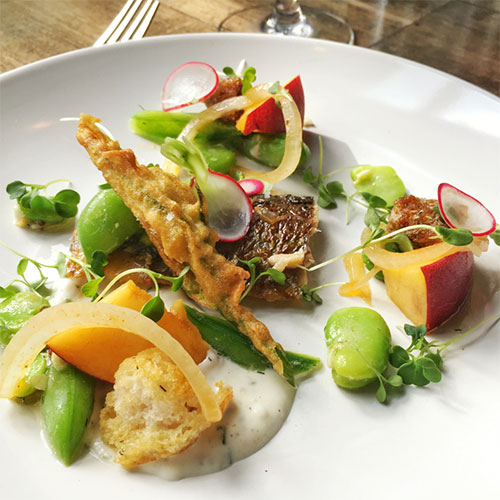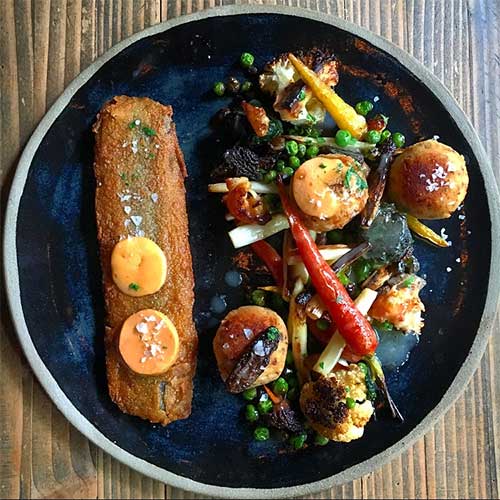|
Fish Factor NW Herring Week aims to restore herring to its proper place as a commercial fishery for human consumptionBy LAINE WELCH
June 20, 2016
To prove that point, nearly 40 of Seattle’s finest restaurants and retailers will celebrate Northwest Herring Week as a way to re-introduce the tasty, health fish to the dining scene. “There’s more herring eaten all over the world than you can imagine. Some years there’s as much as four million tons harvested in the world. You can have a year when the herring fishery is as large as the whole Bering Sea pollock fishery,” said Bruce Schactler of Kodiak, a longtime fisherman and director of the Food Aid Program for the Alaska Seafood Marketing Institute (ASMI). He is helping to coordinate the weeklong event as part of ASMI’s Alaska Herring Development Project.
Togiak Herring “Old Bay” Escabeché from Le Petit Cochon for Northwest Herring Week. For recipes, click here.
Herring long ago disappeared from American menus, although the fish has a mild flavor, similar to trout, and is loaded with healthy omega-3s. Herring week will showcase recipes ranging from smoked, pickled, pates and fancy fillet entrees. Schactler said he was “shocked” when he first tried the dishes at the first Herring Week last year, which only included eight restaurants. “I didn’t know what to expect. You walk into one of these restaurants and they set these beautiful dishes in front of you and by the time you’re done eating, you’re saying I’ll have another,” he said with a laugh. Each year in Alaska more than 40,000 tons of herring are harvested from Southeast to Norton Sound. Nearly all of it is valued for the roe-bearing females, with most of the male fish getting ground up and discarded. Smaller amounts of Alaska herring are used as bait. “Having one of our major processors come up with a customer to supply herring in any other way than bait or roe - I think it’s maybe the first time ever herring has been filleted for food for a commercial market in the state of Alaska. I think it’s a big step forward,” Schactler said.
Bratherring for NW Herring Week from Altstadt in Seattle’s Pioneer Square.
“The market now is in Europe and when you’ve got several million tons being harvested year round right on the doorstep of that primary market, it’s pretty hard for us to ship it half way around the world and compete,” Schactler said. Things could be changing. Deckhand Seafoods took top honors in Food Service for its canned smoked herring at this year’s Alaska Symphony of Seafood, and Ocean Beauty Seafoods has produced canned herring for hunger relief programs, said Tom Sunderland, vice-president of marketing and communications. Meanwhile, Schactler is hopeful that by next year, Northwest Herring Week might put out a call for even more Alaska herring as the program expands along the Pacific Coast. “I can at least help set the table with this development program to where the opportunity is there if any of the Alaska businesses want to take advantage of it,” he said. Northwest Herring Week runs from June 20 – 26. Learn more at www.nwherringweek.com and on Facebook and Twitter. As predicted, global market conditions are far more favorable and Alaska salmon prices are on an upswing. Unlike most years, many salmon fishermen will actually know how much they will get paid even before they set out their nets. At Kodiak, a base price of 95 cents a pound for sockeyes is posted around town, with a nickel more for refrigerated fish. That compares to an average of 65 cents last year. Icicle Seafoods, newly acquired by Canada’s Cooke Aquaculture, has posted a base of $1.15 for sockeyes at its remote Larsen Bay plant on the west side of Kodiak Island. At Bristol Bay, Copper River Seafoods has already posted a base price of 75 cents a pound at its two Bay plants for “excellent” sockeyes, with an extra 15 cents for chilled fish, 10 cents more if the fish is bled, and an additional 25 cents more for reds shipped out fresh. That compares to an average of 63 cents a pound in the Bay in 2015. Plant manager Vojtech Novak told KDLG in Dillingham that the owner of Copper River Seafoods “was a fisherman and always dreamed of knowing the price before going fishing.” He said the company plans to post salmon price information at both plants every Sunday. No word yet from other Bristol Bay processors. Elsewhere, the price for Copper River reds dropped to $2.75 a pound depending on various incentives, down from a whopping $6.50 for fish from the first opener in mid-May. Find more market news from dock to dinner plate in the Sockeye Market Analysis compiled by the McDowell Group for the Bristol Bay Regional Seafood Development Association. It includes markets for other species as well. Skates make up a huge biomass throughout the North Pacific. In Alaska, there have been targeted skate fisheries in the past, but they are mostly taken as bycatch and discarded. The various skate species can live up to 50 years and they have life history characteristics that make them very vulnerable to fishing pressure. A new study aims to find out how many of them die when they are caught and released. “Currently, management assumes 100 percent mortality, whether the skates are retained or discarded. We have anecdotal evidence that’s an exaggeration and it’s likely less,” said Daniel Michrowski, a researcher assistant at the School of Fisheries and Ocean Sciences at the University of Alaska at Fairbanks. Michrowski aims to get better numbers on how many skates die after being caught on longlines, which account for about 70 percent of skate bycatch in the Bering Sea. About 60 million pounds of skates are allowed to be taken incidentally in those waters. “We’ve seen skates coming up with their mouths mangled but they obviously have healed, and you see scar tissue and regrowth in certain areas. So just as halibut can survive with possibly losing part of their jaws, we imagine skates can as well,” he explained. Michrowski said he learned aboard Bering Sea longliners that handling by the crew is one of the biggest factors. Now he plans to compare rough and careful handling outcomes, and monitor injury recoveries with skates taken in the eastern Gulf. He has compiled data on injuries caused by skates being gaffed, ripped off the lines or from automatic hook removers called crucifiers. “Now we are looking to get some skates that are handled more carefully, as you would with halibut,” Michrowski explained. “We want to get both of those groups of skates into the lab to monitor their injury recovery. We are going to take video recordings of their eating attempts to see if there is any impairment – if it takes them longer to feed, if they’re eating less, or if there is a time delay between after they are injured till when they start feeding again. We hope to get a better picture of how those injuries correspond with mortality, and then we can get a rate based on the injury severity as a general mortality rate.” A commercial longliner is needed to capture live skates in Southeast Alaska waters in short stints throughout the summer. They’ll be transported to NOAAs Auke Bay lab in Juneau and monitored for three months. Michrowski said fishery managers will incorporate the results of the skate mortality study into future stock assessments so that future estimates of catch and retention can be more accurate. The skate study is funded by the Pollock Conservation Cooperative. Questions? Contact Michrowski at dbmichrowski@alaska.edu or (907)-796-5461.
Laine Welch ©2016 Laine can be reached
at msfish[AT]alaska.com
SitNews ©2016 Stories In The News Ketchikan, Alaska
|
||


